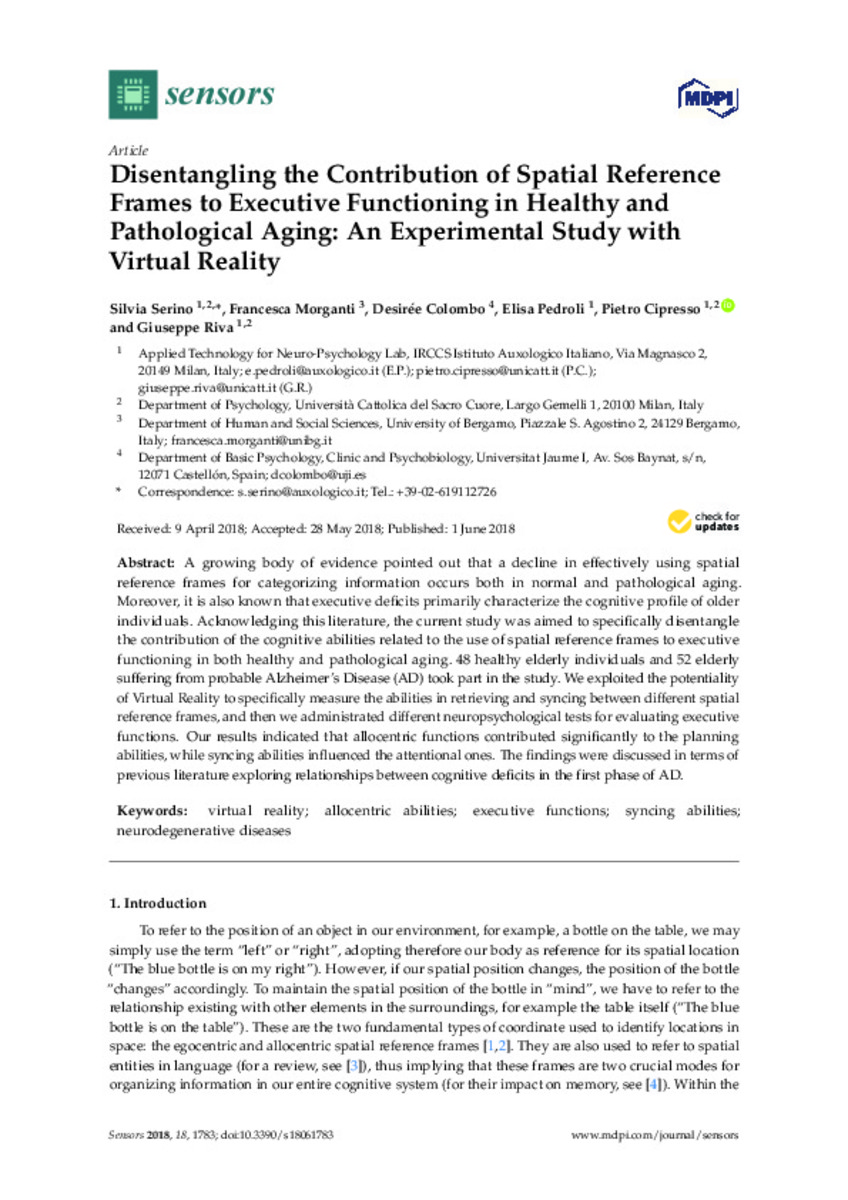Mostrar el registro sencillo del ítem
Disentangling the Contribution of Spatial Reference Frames to Executive Functioning in Healthy and Pathological Aging: An Experimental Study with Virtual Reality
| dc.contributor.author | Serino, Silvia | |
| dc.contributor.author | Morganti, Francesca | |
| dc.contributor.author | Colombo, Desirée | |
| dc.contributor.author | Pedroli, Elisa | |
| dc.contributor.author | Cipresso, Pietro | |
| dc.contributor.author | Riva, Giuseppe | |
| dc.date.accessioned | 2018-11-23T16:56:12Z | |
| dc.date.available | 2018-11-23T16:56:12Z | |
| dc.date.issued | 2018 | |
| dc.identifier.citation | Serino, Silvia, et al. "Disentangling the Contribution of Spatial Reference Frames to Executive Functioning in Healthy and Pathological Aging: An Experimental Study with Virtual Reality." Sensors 18.6 (2018): 1783 | ca_CA |
| dc.identifier.issn | 1424-8220 | |
| dc.identifier.uri | http://hdl.handle.net/10234/177645 | |
| dc.description.abstract | A growing body of evidence pointed out that a decline in effectively using spatial reference frames for categorizing information occurs both in normal and pathological aging. Moreover, it is also known that executive deficits primarily characterize the cognitive profile of older individuals. Acknowledging this literature, the current study was aimed to specifically disentangle the contribution of the cognitive abilities related to the use of spatial reference frames to executive functioning in both healthy and pathological aging. 48 healthy elderly individuals and 52 elderly suffering from probable Alzheimer’s Disease (AD) took part in the study. We exploited the potentiality of Virtual Reality to specifically measure the abilities in retrieving and syncing between different spatial reference frames, and then we administrated different neuropsychological tests for evaluating executive functions. Our results indicated that allocentric functions contributed significantly to the planning abilities, while syncing abilities influenced the attentional ones. The findings were discussed in terms of previous literature exploring relationships between cognitive deficits in the first phase of AD. | ca_CA |
| dc.format.extent | 11 p. | ca_CA |
| dc.format.mimetype | application/pdf | ca_CA |
| dc.language.iso | eng | ca_CA |
| dc.publisher | MDPI | ca_CA |
| dc.relation.isPartOf | Sensors, 2018, vol. 18, núm. 6 | ca_CA |
| dc.rights | © 2018 by the authors. Licensee MDPI, Basel, Switzerland. This article is an open access article distributed under the terms and conditions of the Creative Commons Attribution (CC BY) license (http://creativecommons.org/licenses/by/4.0/). | ca_CA |
| dc.rights | Atribución 4.0 Internacional | * |
| dc.rights.uri | http://creativecommons.org/licenses/by-sa/4.0/ | * |
| dc.subject | virtual reality | ca_CA |
| dc.subject | allocentric abilities | ca_CA |
| dc.subject | executive functions | ca_CA |
| dc.subject | syncing abilities | ca_CA |
| dc.subject | neurodegenerative diseases | ca_CA |
| dc.title | Disentangling the Contribution of Spatial Reference Frames to Executive Functioning in Healthy and Pathological Aging: An Experimental Study with Virtual Reality | ca_CA |
| dc.type | info:eu-repo/semantics/article | ca_CA |
| dc.identifier.doi | https://doi.org/10.3390/s18061783 | |
| dc.relation.projectID | This work was partially supported by the Italian funded project “High-end and Low-End Virtual Reality Systems for the Rehabilitation of Frailty in the Elderly” (PE-2013-02355948) | ca_CA |
| dc.rights.accessRights | info:eu-repo/semantics/openAccess | ca_CA |
| dc.relation.publisherVersion | https://www.mdpi.com/1424-8220/18/6/1783/htm | ca_CA |
| dc.type.version | info:eu-repo/semantics/publishedVersion | ca_CA |
Ficheros en el ítem
Este ítem aparece en la(s) siguiente(s) colección(ones)
-
PSB_Articles [1303]
Articles de publicacions periòdiques
Excepto si se señala otra cosa, la licencia del ítem se describe como: © 2018 by the authors. Licensee MDPI, Basel, Switzerland. This article is an open access
article distributed under the terms and conditions of the Creative Commons Attribution
(CC BY) license (http://creativecommons.org/licenses/by/4.0/).








